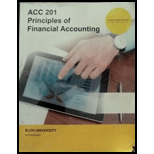
Principles of Financial Accounting (Elon University)
11th Edition
ISBN: 9781308839233
Author: Marshall
Publisher: McGraw-Hill Education
expand_more
expand_more
format_list_bulleted
Textbook Question
Chapter 5, Problem 5.16E
Exercise 5.16
LO 6
Notes receivable-interest accrual and collection Husemann Co.’s assets include notes receivable from customers. During fiscal 2016, the amount of notes receivable averaged $277,500, and the interest rate of the notes averaged 5.2%.
Required:
- Calculate the amount of interest income earned by Husemann Co. during fiscal 2016 and show in the horizontal model or write a
journal entry that accrues the interest income earned from the notes. - If the balance in the Interest Receivable account increased by $3,500 from the beginning to the end of the fiscal year, how much interest receivable was collected during the fiscal year? Use the horizontal model, a T-account, or write the journal entry to show the collection of this amount.
Expert Solution & Answer
Want to see the full answer?
Check out a sample textbook solution
Students have asked these similar questions
how much long-term debt did the firm have? general accounting
Assume that 5% of the L.L. Bean boots are returned by customers for various reasons. L. Bean has a 100% refund policy for returns, no matter what the reason. What would the journal entry be to accrue L.L. Bean's sales returns for this one pair of boots? (Note: L.L. Bean most likely will make monthly/quarterly adjusting entries for the total sales returns accruals, but here we will just look at the accrual associated with the sale of one pair of boots.)
What was the percentage rate of return on plan aasets
Chapter 5 Solutions
Principles of Financial Accounting (Elon University)
Ch. 5 - Prob. 5.1MECh. 5 - Prob. 5.2MECh. 5 - Mini-Exercise 5.3 LO 5 Accounts receivable, bad...Ch. 5 - Mini-Exercise 5.4 LO 5 Bad debts...Ch. 5 - Mini-Exercise 5.5 LO 7, 8 Cost flow...Ch. 5 - Mini-Exercise 5.6 LO 7, 8 Cost flow...Ch. 5 - Prob. 5.7ECh. 5 - Prob. 5.8ECh. 5 - Prob. 5.9ECh. 5 - Prob. 5.10E
Ch. 5 - Exercise 5.11 LO 5 Bad debts analysis-Allowance,...Ch. 5 - Exercise 5.12 LO 5 Bad debts analysis-Allowance...Ch. 5 - Exercise 5.13 LO 5 Cash discounts-ROI Annual...Ch. 5 - Prob. 5.14ECh. 5 - Exercise 5.15 LO 6 Notes receivable-interest...Ch. 5 - Exercise 5.16 LO 6 Notes receivable-interest...Ch. 5 - Exercise 5.17 LO 7, 8 LIFO versus FIFO-matching...Ch. 5 - Prob. 5.18ECh. 5 - Prob. 5.19ECh. 5 - Prob. 5.20ECh. 5 - Exercise 5.21 LO 5, 6, 8 Transaction...Ch. 5 - Exercise 5.22 LO 5. 8, 10 Transaction...Ch. 5 - Exercise 5.23 LO 5, 6, 7 Transaction...Ch. 5 - Exercise 5.24 LO 7, 8, 10 Transaction...Ch. 5 - Prob. 5.25PCh. 5 - Prob. 5.26PCh. 5 - Problem 5.27 LO 5 Bad debts analysis-Allowance...Ch. 5 - Problem 5.28 LO 5 Bad debts analysis-Allowance...Ch. 5 - Problem 5.29 LO 5 Analysis of accounts receivable...Ch. 5 - Problem 5.30 LO 5 Analysis of accounts receivable...Ch. 5 - Problem 5.31 LO 7, 8 Cost flow assumptions-FIFO...Ch. 5 - Problem 5.32 LO 7, 8 Cost flow assumptions-FIFO,...Ch. 5 - Prob. 5.33PCh. 5 - Prob. 5.34PCh. 5 - Problem 5.35 LO 7 Effects of inventory errors If...Ch. 5 - Prob. 5.36PCh. 5 - Case 5.37 LO 5, 7, 8 Focus company-accounts...Ch. 5 - Case 5.38
LO 5, 7
Comparative analysis of current...
Knowledge Booster
Learn more about
Need a deep-dive on the concept behind this application? Look no further. Learn more about this topic, accounting and related others by exploring similar questions and additional content below.Similar questions
- For the current year ended March 31, Cosgrove Company expects fixed costs of $579,000, a unit variable cost of $68, and a unit selling price of $89. a. Compute the anticipated break-even sales (units). b. Compute the sales (units) required to realize an operating income of $134,000. (Round your answer to nearest units)arrow_forwardL.L. Bean operates two factories that produce its popular Bean boots (also known as "duck boots") in its home state of Maine. Since L.L. Bean prides itself on manufacturing its boots in Maine and not outsourcing, backorders for its boots can be high. In 2014, L.L. Bean sold about 450,000 pairs of the boots. At one point during 2014, it had a backorder level of about 100,000 pairs of boots. L.L. Bean can manufacture about 2,200 pairs of its duck boots each day with its factories running 24/7. In 2015, L.L. Bean expects to sell more than 500,000 pairs of its duck boots. As of late November 2015, the backorder quantity for Bean Boots was estimated to be about 50,000 pairs.arrow_forwardcorrect answer pleasearrow_forward
- 1. Assume there is a 7% sales tax rate in Ohio, where the customer who ordered the boots is located. The sales tax on the order would be $7.63, which L.L. Bean adds to the invoice total. Is the $7.63 added to L.L. Bean's sales revenue? Why or why not?arrow_forwardWhat are its after tax earnings? Accountingarrow_forwardcan you please solve this questionsarrow_forward
arrow_back_ios
SEE MORE QUESTIONS
arrow_forward_ios
Recommended textbooks for you
 Financial Accounting: The Impact on Decision Make...AccountingISBN:9781305654174Author:Gary A. Porter, Curtis L. NortonPublisher:Cengage Learning
Financial Accounting: The Impact on Decision Make...AccountingISBN:9781305654174Author:Gary A. Porter, Curtis L. NortonPublisher:Cengage Learning Intermediate Accounting: Reporting And AnalysisAccountingISBN:9781337788281Author:James M. Wahlen, Jefferson P. Jones, Donald PagachPublisher:Cengage Learning
Intermediate Accounting: Reporting And AnalysisAccountingISBN:9781337788281Author:James M. Wahlen, Jefferson P. Jones, Donald PagachPublisher:Cengage Learning

Financial Accounting: The Impact on Decision Make...
Accounting
ISBN:9781305654174
Author:Gary A. Porter, Curtis L. Norton
Publisher:Cengage Learning

Intermediate Accounting: Reporting And Analysis
Accounting
ISBN:9781337788281
Author:James M. Wahlen, Jefferson P. Jones, Donald Pagach
Publisher:Cengage Learning
7.2 Ch 7: Notes Payable and Interest, Revenue recognition explained; Author: Accounting Prof - making it easy, The finance storyteller;https://www.youtube.com/watch?v=wMC3wCdPnRg;License: Standard YouTube License, CC-BY